Starting from:
$14.95
Home
World War II
World War II War Department Operational Decisions & Actions Daily White House Summaries - Downloa
World War II War Department Operational Decisions & Actions Daily White House Summaries - Downloa
World War II: War Department Operational Decisions and Actions Daily White House Summaries
9,591 pages of the Daily Summary War Department Operational Decisions and Actions Respecting Hostilities with Axis reports (All theaters of war). 1,217 reports dating from December 11, 1941 to April 12, 1945.
The White House Summary was a modified version of the War Department Daily Operational Summary. These summary reports were created by the War Department and sent to the Roosevelt White House. They cover the European, Pacific, Southwest Pacific, Mediterranean, Asiatic theaters of war and Soviet activity on the Eastern Front.
In "The War Department: Washington Command Post: The Operations Division (1950)," Ray S. Cline, Department of Defense historian wrote that, "Immediately after Pearl Harbor the War Department's War Plans Division became the War Department center for current information concerning or affecting Army operations. Upon specific orders from the Chief of Staff, WPD undertook to report daily, for the benefit of the War Department and the President, the 'operational decisions and actions of the War Department.' For that purpose all other divisions of the General Staff and the Army Air Forces reported to WPD on their individual actions. The Daily Summary, including the abridged form called the White House Summary, was prepared in much the same form throughout the war. From its knowledge of strategic plans and from the detailed operational information made available by other Army agencies, WPD amassed a uniquely comprehensive understanding of current military issues, particularly the urgent ones under consideration by the Chief of Staff."
The purpose of these reports, which were classified as SECRET or TOP SECRET until 1972, was to provide a synopsis of the operational decisions and the actions taken by the War Department during World War II to the Roosevelt White House. They included maps and charts highlighting the progress of campaigns and battles, locations of air operations, and movements of Allied and Axis forces.
The War Department's War Plans Division staff compiled information from various sources, including situation and war progress reports from the Army and Navy Departments, U.S. Joint Chiefs of Staff, Combined Chiefs of Staff, military commanders and observers and intelligence reports. These summaries were usually delivered to the White House daily at 5:00 PM and covered the twenty-four hour period ending at 2:00 PM.
Earlier reports broke down the information by geographic area, e.g., North America, Latin America, Europe, Africa and the Middle East, and Pacific Ocean. As United States involvement expanded world-wide the information was presented by the operational areas, fronts, theaters, and specific country or geographic location, e.g., Asiatic theater, CBI theater, Eastern front, European theater, Mediterranean Area, North Africa, South West Pacific Area (SWPA), Western front, and Western Hemisphere.
The summaries follow the progression of American participation in the war. The first reports deal with the response to advances made by Japanese forces throughout the Pacific. For the first few months much attention is given to decisions involving the buildup of forces in Australia, Allied command and control coordination and delineation of operational areas, defensive operations, buildup of U.S forces in Iceland and Northern Ireland, changes in Lend Lease aid, and U.S. military and air force deployments.
As the war widens the subjects in the reports follow, by covering air, ground, and naval deployments, evaluations of enemy capabilities and intentions, training, and war production. As the United States combat role increases attention focuses on battles and campaigns, United States and Allied war planning and directives, the result of air operations, and casualty reports.
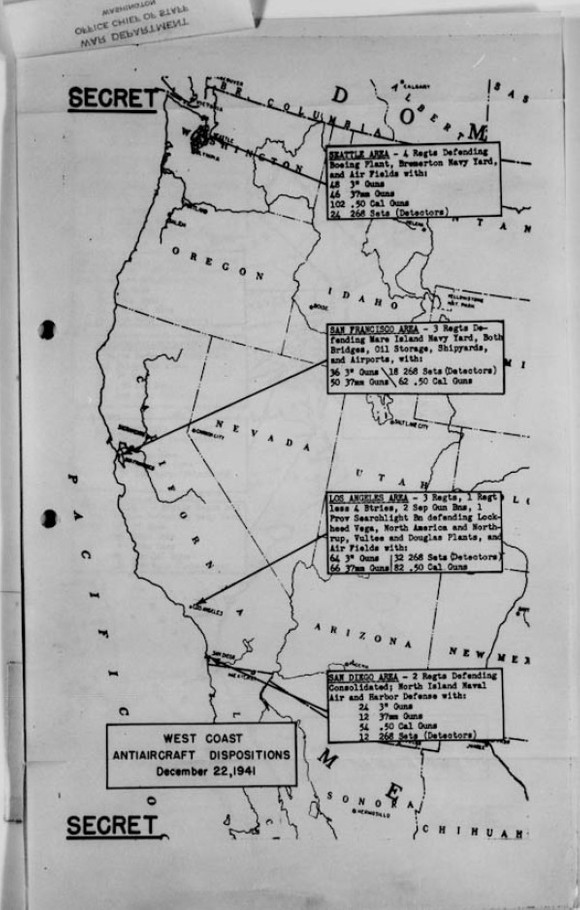
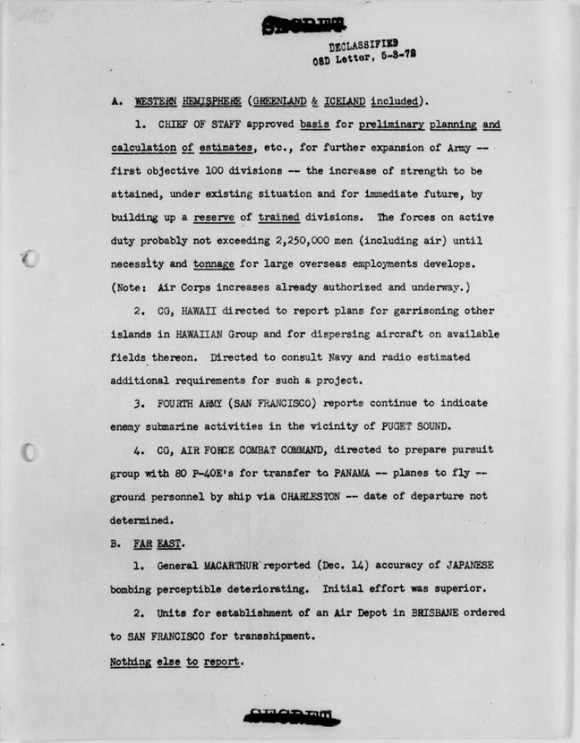
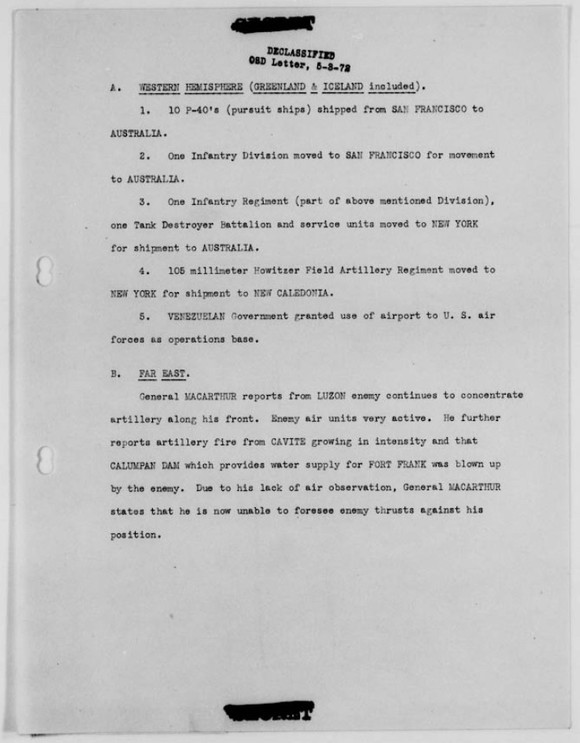
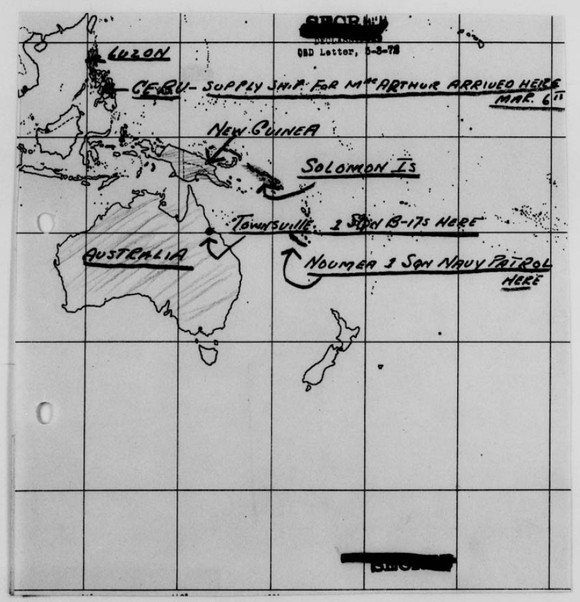

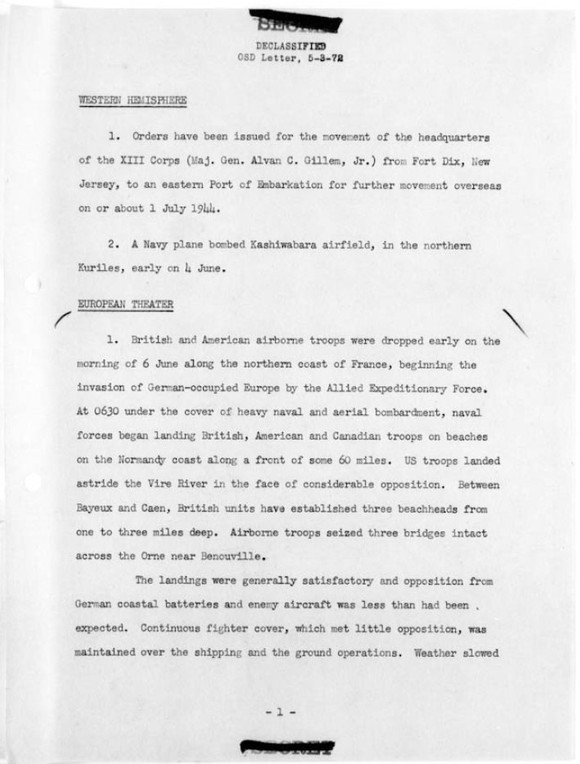




9,591 pages of the Daily Summary War Department Operational Decisions and Actions Respecting Hostilities with Axis reports (All theaters of war). 1,217 reports dating from December 11, 1941 to April 12, 1945.
The White House Summary was a modified version of the War Department Daily Operational Summary. These summary reports were created by the War Department and sent to the Roosevelt White House. They cover the European, Pacific, Southwest Pacific, Mediterranean, Asiatic theaters of war and Soviet activity on the Eastern Front.
In "The War Department: Washington Command Post: The Operations Division (1950)," Ray S. Cline, Department of Defense historian wrote that, "Immediately after Pearl Harbor the War Department's War Plans Division became the War Department center for current information concerning or affecting Army operations. Upon specific orders from the Chief of Staff, WPD undertook to report daily, for the benefit of the War Department and the President, the 'operational decisions and actions of the War Department.' For that purpose all other divisions of the General Staff and the Army Air Forces reported to WPD on their individual actions. The Daily Summary, including the abridged form called the White House Summary, was prepared in much the same form throughout the war. From its knowledge of strategic plans and from the detailed operational information made available by other Army agencies, WPD amassed a uniquely comprehensive understanding of current military issues, particularly the urgent ones under consideration by the Chief of Staff."
The purpose of these reports, which were classified as SECRET or TOP SECRET until 1972, was to provide a synopsis of the operational decisions and the actions taken by the War Department during World War II to the Roosevelt White House. They included maps and charts highlighting the progress of campaigns and battles, locations of air operations, and movements of Allied and Axis forces.
The War Department's War Plans Division staff compiled information from various sources, including situation and war progress reports from the Army and Navy Departments, U.S. Joint Chiefs of Staff, Combined Chiefs of Staff, military commanders and observers and intelligence reports. These summaries were usually delivered to the White House daily at 5:00 PM and covered the twenty-four hour period ending at 2:00 PM.
Earlier reports broke down the information by geographic area, e.g., North America, Latin America, Europe, Africa and the Middle East, and Pacific Ocean. As United States involvement expanded world-wide the information was presented by the operational areas, fronts, theaters, and specific country or geographic location, e.g., Asiatic theater, CBI theater, Eastern front, European theater, Mediterranean Area, North Africa, South West Pacific Area (SWPA), Western front, and Western Hemisphere.
The summaries follow the progression of American participation in the war. The first reports deal with the response to advances made by Japanese forces throughout the Pacific. For the first few months much attention is given to decisions involving the buildup of forces in Australia, Allied command and control coordination and delineation of operational areas, defensive operations, buildup of U.S forces in Iceland and Northern Ireland, changes in Lend Lease aid, and U.S. military and air force deployments.
As the war widens the subjects in the reports follow, by covering air, ground, and naval deployments, evaluations of enemy capabilities and intentions, training, and war production. As the United States combat role increases attention focuses on battles and campaigns, United States and Allied war planning and directives, the result of air operations, and casualty reports.










1 file (1.2GB)



